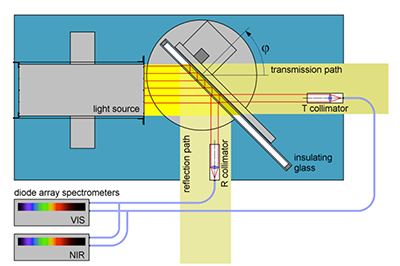Contact: Dr Andreas Schüler
For novel types of innovative architectural glazing, the thermo-optical properties of the glazing play an important role in energy management of the building.
The investigated advanced architectural glazing include innovative sun protection coatings with improved ratio of visible and energetic transmittance, as well as glazing integrated transparent and translucent photovoltaic modules based on dye-sensitized solar cells.
Recent work initiated originally by Prof. Peter Oelhafen showed that the ratio of visible and energetic transmittance can be significantly improved, thereby providing higher levels of daylighting for the same amount of solar energy gains, or less overheating in summer at the same level of daylighting. We performed computer simulations of thin film interference in order to identify suitable multilayer designs for the envisaged novel sun protection coatings. Glazing being equipped with such multilayered coatings has been produced in collaboration with Glas Trösch, and is now displayed in a demonstration installation at the University of Basel.
Attractive features of the façade integration of photovoltaics based on dye-colored solar cells is the option of transparency and the wide range of possible color shades in transmission. By angle‑dependent spectrophotometry and thermo-optical experiments, we determine the visible and energetic transmittance/reflectance, the g-value, the CIE color coordinates in transmission/reflection, and the color rendering index CRI. This information is important for the visual and thermal comfort inside the building.
Most relevant publication
O. Bouvard, S. Vanzo, A. Schüler, Experimental determination of optical and thermal properties of semi-transparent photovoltaic modules based on dye-sensitized solar cells, (2015) Energy Procedia, 78, pp. 453-458.
DOI: 10.1016/j.egypro.2015.11.696

The properties of a large number of glasses are accessible through the glassdbase.ch, a database built by University of Basel and now hosted by EPFL.
glassdbase in an independent and comprehensive database for building glass. It is the place to find data on commercial insulating glasses determined at the Institute of Physics at the University of Basel and EPFL. glassdbase is focused on sun protection glasses.
The database reveals among others the following angular dependent data on insulating glasses:
– spectral transmittance T, spectral reflectance R, and spectral absorptance A
– solar direct transmittance Te, solar direct reflectance Re, and solar direct absorptance Ae
– light transmittance Tv, and light reflectance Rv
– total solar energy transmittance g (g-factor)
– detailed color information on the transmitted and reflected daylight
– general color rendering index Ra